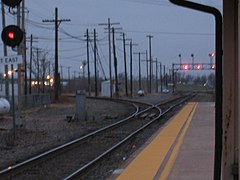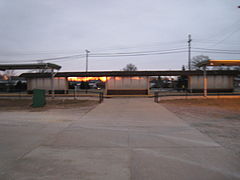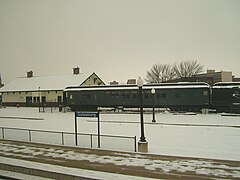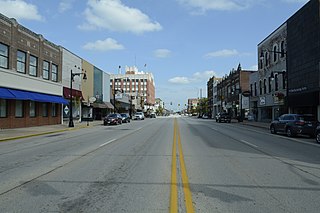
Galesburg is a city in Knox County, Illinois, United States. The city is 45 miles (72 km) northwest of Peoria. At the 2010 census, its population was 32,195. It is the county seat of Knox County and the principal city of the Galesburg Micropolitan Statistical Area, which includes all of Knox and Warren counties.

The California Zephyr was a passenger train that ran between Chicago, Illinois, and Oakland, California, via Omaha, Denver, Salt Lake City, Winnemucca, Oroville and Pleasanton in the United States. It was operated by the Chicago, Burlington & Quincy (CB&Q), Denver & Rio Grande Western (D&RGW) and Western Pacific (WP) railroads, all of which dubbed it "the most talked about train in America" on March 19, 1949, with the first departure the following day. The train was scheduled to pass through the most spectacular scenery on its route in the daylight. The original train ceased operation in 1970, though the D&RGW continued to operate its own passenger service, the Rio Grande Zephyr, between Salt Lake City and Denver, using the original equipment until 1983. In 1983 a second iteration of the California Zephyr, an Amtrak service, was formed. The current version of the California Zephyr operates partially over the route of the original Zephyr and partially over the route of its former rival, the City of San Francisco.

The Chicago, Burlington and Quincy Railroad was a railroad that operated in the Midwestern United States. Commonly referred to as the Burlington Route, the Burlington, CB&Q, or as the Q, it operated extensive trackage in the states of Colorado, Illinois, Iowa, Missouri, Nebraska, Wisconsin, Wyoming, and also in Texas through subsidiaries Colorado and Southern Railway, Fort Worth and Denver Railway, and Burlington-Rock Island Railroad. Its primary connections included Chicago, Minneapolis–Saint Paul, St. Louis, Kansas City, and Denver. Because of this extensive trackage in the midwest and mountain states, the railroad used the advertising slogans "Everywhere West", "Way of the Zephyrs", and "The Way West".

Saint Paul Union Depot is a historic railroad station and intermodal transit hub in the Lowertown neighborhood of Saint Paul, Minnesota. It serves light rail, intercity rail, intercity bus, and local bus services.

The Illinois Zephyr and Carl Sandburg are a pair of passenger trains operated by Amtrak on a 258-mile (415 km) route between Chicago and Quincy, Illinois. As Illinois Service trains, they are partially funded by the Illinois Department of Transportation. Between Chicago and Galesburg, Illinois, the trains share their route with the California Zephyr and Southwest Chief; the remainder of the route (Galesburg–Quincy) is served exclusively by the Illinois Zephyr/Carl Sandburg.

The American Royal Zephyr was a streamlined passenger train service operated by the Chicago, Burlington and Quincy Railroad between Chicago and Kansas City. This CB&Q Zephyr was named for the American Royal, one of the Midwest's largest and oldest livestock exhibition, professional rodeo, and horse show.

The Nebraska Zephyr was a streamlined passenger train operated by the Chicago, Burlington and Quincy Railroad between Chicago, Illinois; Omaha, Nebraska; and Lincoln, Nebraska, from 1947 to 1971. Until 1968, the service was provided by two Twin Cities Zephyr articulated trainsets — the "Train of the Gods" and "Train of the Goddesses" — that became synonymous with it. The Nebraska Zephyr was one of many trains discontinued when Amtrak began operations in 1971. The "Train of the Goddesses" set is preserved at the Illinois Railway Museum in Union, Illinois.

The BNSF Line is a Metra commuter rail line operated by the BNSF Railway in Chicago and its western suburbs, running from Chicago Union Station to Aurora, Illinois through the Chicago Subdivision. In 2010, the BNSF Line continued to have the highest weekday ridership of the 11 Metra lines. While Metra does not refer to its lines by particular colors, the BNSF line's color on Metra timetables is "Cascade Green," in honor of the Burlington Northern Railroad.

The Kansas City Zephyr was a streamliner passenger train service operated by the Chicago, Burlington and Quincy Railroad (CB&Q) between Chicago and Kansas City.

Plano station, also known as the Chicago, Burlington and Quincy Railroad Depot is an Amtrak intercity train station in Plano, Illinois, United States. The station was added to the U.S. National Register of Historic Places on November 12, 1993.
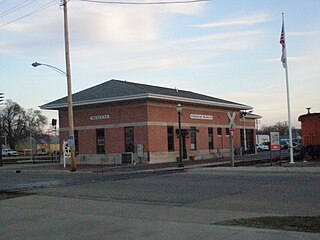
Mendota station is an Amtrak intercity train station at 783 Main Street, Mendota, Illinois, United States.

Macomb station is an Amtrak intercity train station in Macomb, Illinois, United States. There is one daily morning train to Chicago. In the evening, the return train continues on to Quincy, Illinois. The station is a brick structure constructed around 1913 by the Chicago, Burlington and Quincy Railroad as designed by the railroad's architect Walter Theodore Krausch. The city of Macomb leases the station from BNSF Railway to prevent demolition and has done so since 1971.
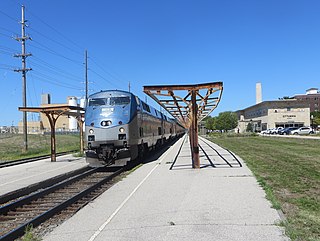
Ottumwa station is an Amtrak intercity train station in Ottumwa, Iowa, United States. The station was originally built by the Chicago, Burlington and Quincy Railroad, and has been listed as Burlington Depot by the National Register of Historic Places since November 26, 2008. It became a contributing property in the Historic Railroad District in 2011.

Holdrege station is an Amtrak intercity train station in Holdrege, Nebraska, served by the California Zephyr. It was originally opened in February 1911 by the Chicago, Burlington and Quincy Railroad as the CB&Q Holdrege Depot, and the depot has been listed on the National Register of Historic Places since February 21, 1997. However, the depot is no longer part of the station facilities.

The Chicago and Aurora Railroad was a direct predecessor of the Chicago, Burlington and Quincy Railroad. Its original incorporation as the Aurora Branch Railroad, chartered in February 1849, started as a twelve-mile branch line which Class I giant BNSF cites as the beginning of their empire: this “short stretch of track set BNSF’s destiny into ‘loco-motion’ and grew over many decades into a network spanning 32,500 miles.” Beginning in 1853, as the Chicago and Aurora Railroad, the company's tracks eventually extended from Chicago to Mendota via Aurora, Illinois, also creating what would become the oldest commuter line in the Chicago area.

Streator Station was a train station located in Streator, Illinois, United States. It was served by numerous Atchison, Topeka and Santa Fe Railway (AT&SF) passenger trains during its heyday. Amtrak served the station until 1996 with the Southwest Chief between Chicago and Los Angeles daily. When the Burlington Northern Railroad and the AT&SF railways merged, BNSF built a connecting track between the two main lines east of Cameron, Illinois,. This allowed passenger trains to change from the former Chicago, Burlington and Quincy Railroad (CB&Q) main line to the Southern Transcon freely. This along with the amendment of a stretch of track that was essential for getting to Chicago Union Station forced Amtrak to reroute the Southwest Chief to bypass Chillicothe and Streator.

Galesburg Santa Fe Station was a railway station in the west central Illinois town of Galesburg. The station was along the Atchison, Topeka and Santa Fe Railway's main line and served trains such as the Super Chief and El Captain. After Amtrak took over intercity rail in the United States, it was served by trains such as the Lone Star (1971–1979) and the Southwest Chief (1971–1996).
The Cameron connector is a section of track built in 1995–1996 which connects the former Burlington Northern Railroad and the former Atchison, Topeka and Santa Fe Railway tracks, both which are now part of the BNSF Railway, to each other near Cameron, Illinois.

The California Zephyr is a long-distance passenger train operated by Amtrak between Chicago and the San Francisco Bay Area, via Omaha, Denver, Salt Lake City, and Reno. At 2,438 miles (3,924 km), it is Amtrak's longest daily route, and second-longest overall after the Texas Eagle's triweekly continuation from San Antonio to Los Angeles, with travel time between the termini taking approximately 511⁄2 hours. Amtrak claims the route as one of its most scenic, with views of the upper Colorado River valley in the Rocky Mountains, and the Sierra Nevada. The modern train is the second iteration of a train named California Zephyr; the original train was privately operated and ran on a different route through Nevada and California.

The Galesburg Yard is a classification yard of the BNSF Railway south of Galesburg in Illinois. It dates back to a goods and classification yard of the Chicago, Burlington and Quincy Railroad (CB&Q), which from 1905 developed into one of the largest classification yards in the USA. At the beginning of the 20th century, Galesburg developed into CB&Q's most important railroad junction, with the main lines from Saint Paul to St. Louis and Kansas City (north-south) and from Chicago to Omaha and Kansas City (east-west) running through it. Nearly all CB&Q's passenger and freight trains passed through Galesburg, where there was also a large railroad depot with several roundhouses.




